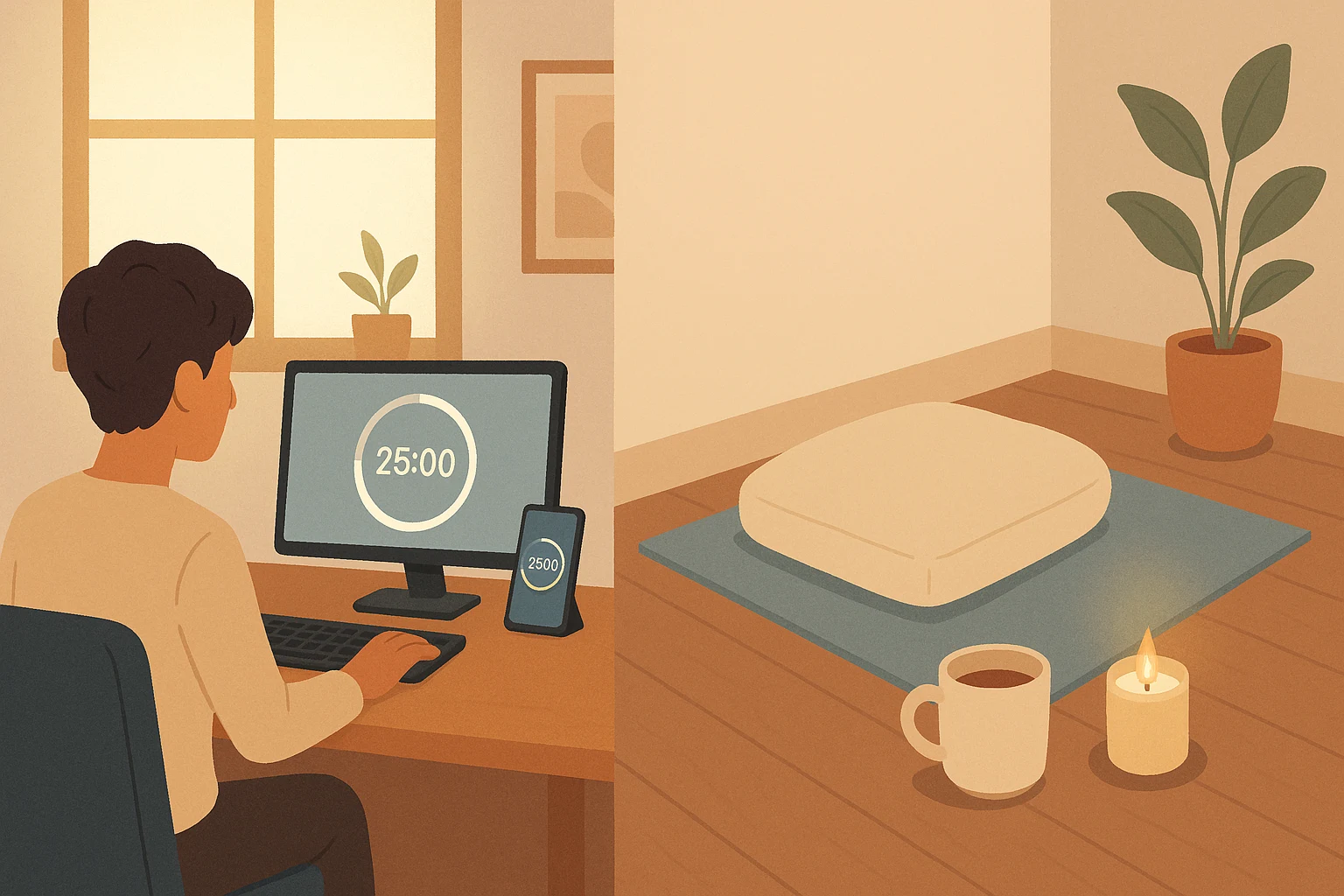
Feeling buried by distractions? In about 60 seconds, mindfulness techniques for focus can steady your attention and make the next task feel clearer. Sarah—a remote worker—was drowning in emails until she tried one short exercise and felt noticeably less distracted. If you’re juggling deadlines, studying late, or dealing with digital overload, it’s easy to get knocked off track. Mindfulness offers simple practices, grounded in research, that fit into a packed day. For more on stress relief, see our mindfulness stress relief guide, then dive into the attention-focused practices below.
Try a 60-Second Attention Trick!Table of Contents
- Benefits of Mindfulness Techniques for Focus
- Understanding Mindfulness and Its Role in Focus
- Mindfulness Techniques for Focus: Effective Practices
- Overcoming Mindfulness Challenges
- Productive Presence in a Busy Schedule
- Interactive Tool: Choose Your Mindfulness Technique for Focus
- Frequently Asked Questions
- Conclusion: Cultivating a Focused Mind
Benefits of Mindfulness Techniques for Focus
- Mindfulness may boost attention: It can help your brain filter distractions, keeping you on task.
- Small practices, meaningful results: Even a few minutes daily may enhance concentration and reduce mental clutter.
- Versatile methods: From meditation to mindful eating, these techniques fit any busy schedule.
- Support mental clarity: Mindfulness has been linked to changes in brain areas that help with attention and memory.
- Ease digital overload: These practices can help you step back from nonstop pings and multitasking.
Understanding Mindfulness and Its Role in Focus
Before we dive in, a quick refresher: mindfulness means paying attention to what’s here, without judging it. It’s noticing thoughts and surroundings as they are—no fixing, no chasing.
For focus, mindfulness is like a workout for your attention. Imagine your focus as a spotlight: distractions make it jump, but mindfulness steadies it. A 2018 study in Frontiers in Human Neuroscience suggests mindfulness can enhance aspects of attention.
Neural Benefits of Mindfulness for Focus
- Prefrontal engagement: Practice may support activity in regions involved in planning and attention.
- Amygdala regulation: Some studies suggest mindfulness may relate to lower reactivity, which can reduce anxiety-driven distractions.
- Neuroplasticity signals: A 2011 Psychiatry Research: Neuroimaging study reported gray-matter changes in attention-related regions (add citation).
“Mindfulness is simply being aware of what is happening right now without wishing it were different; enjoying the pleasant without holding on when it changes (which it will); being with the unpleasant without resisting when it is there (which it is).”
— James BarazUltimately, mindfulness empowers you to guide your attention, which can be valuable for anyone facing information overload.
This post has affiliate links. We may earn a commission. Learn more.

Mindfulness Techniques for Focus: Effective Practices
Below are five powerful concentration practices rooted in mindfulness to enhance attention—practical focus mindfulness exercises you can try today.
1. Focused Attention Meditation (FAM)
Focused Attention Meditation is a core attention-building technique in mindfulness. It involves anchoring your attention on your breath and redirecting it when it wanders.
How It Helps Your Attention
Focusing on your breath can help train your brain’s attention networks. Each return from a distraction supports pathways that filter irrelevant stimuli.
When to Use It
- Morning Start: Set a focused tone for the day.
- Before Deep Work: Get your brain ready for a tough task.
- Midday Reset: Clear the mental clutter.
How to Practice Focused Attention Meditation
- Find a Quiet Spot: Sit comfortably, spine straight, eyes closed or softly gazed.
- Choose Your Anchor: Focus on your breath’s sensations (nostrils, belly, or chest).
- Notice Wandering: Acknowledge thoughts without judgment.
- Gently Return: Notice the distraction and come back to the breath.
- Repeat: Continue for 5–20 minutes.
Quick Tip: Don’t stress if your mind wanders—it’s normal! Each return can build attention.
2. Pomodoro with Mindful Breaks
The Pomodoro Technique uses 25-minute work intervals with short breaks. Adding mindful breaks makes it a go-to attention technique—a staple of mindful productivity.
How It Helps Your Attention
Pomodoro can foster sustained engagement, while mindful breaks (e.g., breathing) help prevent distraction loops and may support recovery.
When to Use It
- Long Work Sessions: Ideal for big projects.
- Procrastination: Breaks tasks into manageable chunks.
- Digital Overload: Steps away from screens.
How to Practice Pomodoro with Mindful Breaks
- Choose a Task: Focus on one task.
- Set a Timer: Work for 25 minutes without distractions.
- Mindful Break (5 Minutes): Try deep breathing or stretching.
- Repeat: After four cycles, take a 15–30-minute mindful break.
Quick Tip: Use a timer app like Focus Booster for Pomodoro cycles.

3. Visual Concentration Drills (e.g., Candle Gazing)
This ancient practice, Trataka, involves focusing on a visual point like a candle flame to train attention—one of the simplest concentration practices.
How It Boosts Focus
Gazing may reduce visual processing demands and support a calmer mind; small studies suggest potential attention benefits.
When to Use It
- Before Reading/Analysis: Prepares for visual tasks.
- Feeling Scattered: Grounds attention.
- Evening Wind-Down: Calms before sleep.
How to Practice Visual Concentration Drills
- Choose an Object: Use a candle flame or small item.
- Position Yourself: Sit 2–3 feet away, eye level.
- Gaze Softly: Focus without straining, noting details.
- Allow Thoughts to Pass: Return to the object.
- Duration: Start with 1–2 minutes, increase to 5–10.
Quick Tip: Blink naturally to avoid eye strain during gazing.
4. Single-Task Eating or Walking
These everyday activities become powerful mindfulness exercises to improve concentration when done with full attention. To dive deeper into eating, explore this mindful eating exercises guide, or try a mindful walking meditation for focused steps.
How It Helps Your Attention
Single-tasking pushes back on multitasking. It engages your senses and reduces mind-wandering, which may lift awareness.
When to Use It
- Meal Times: Transform lunch into an attention practice.
- Commutes/Breaks: Make walking mindful.
- Feeling Rushed: Slow down and reconnect.
How to Practice Single-Task Eating or Walking
Mindful Eating:
- Remove Distractions: Turn off screens.
- Observe: Notice food’s colors, shapes, textures.
- Smell and Taste: Savor each bite slowly.
- Pause: Reflect on satiety.
Mindful Walking:
- Tune In: Feel your feet, legs, and breath.
- Engage Senses: Notice sounds or sights.
- Let Thoughts Pass: Return to walking sensations.
Quick Tip: Start with one mindful bite or step to build the habit.
5. Mindful Listening
Giving full attention to sounds—or to someone speaking—is a powerful mindfulness technique for attention.
How It Boosts Focus
It trains your listening muscles, often improving comprehension and cutting down on distractions—and it can support empathy too.
When to Use It
- Conversations: Show up better in meetings or conversations.
- Music Listening: Turn music into an attention exercise.
- Surrounded by Sounds: Use ambient noise as your anchor.
How to Practice Mindful Listening
To a Person:
- Be Present: Put away devices, maintain eye contact.
- Listen to Understand: Focus on words and tone.
- Notice Reactions: Acknowledge judgments and refocus.
To Sounds:
- Choose a Sound: Music or ambient noise.
- Focus: Notice pitch or rhythm.
- Return: Bring attention back when it wanders.
Quick Tip: Try listening to one song mindfully to sharpen attention.
Summary of Concentration Practices
| Technique | Time Required | Best For | Benefits |
|---|---|---|---|
| Focused Attention Meditation | 5–20 min | Deep work, morning prep | Strengthens attention, reduces distractions |
| Pomodoro with Mindful Breaks | 25 min + 5 min breaks | Long tasks, procrastination | Can boost productivity, may reduce fatigue |
| Visual Concentration Drills | 1–10 min | Reading, calming scattered mind | May improve visual attention, supports a calmer mind |
| Single-Task Eating/Walking | 5–15 min | Daily routines, rushed moments | Enhances sensory awareness |
| Mindful Listening | 2–10 min | Conversations, ambient sounds | Boosts auditory attention, empathy |
Overcoming Mindfulness Challenges
Getting started can feel tricky, especially if your mind wanders or stress takes over. Here’s how to tackle common hurdles. For extra help with stress, try this breathwork for anxiety guide.
- Wandering Mind: It’s normal! Start with 1-minute sessions and celebrate each return.
- High Stress: Try visual gazing in a quiet space to ground yourself.
- Lack of Time: Use 60-second breaths while waiting for coffee.
- Beginner Frustration: Use apps like Insight Timer for guided support.
Mindful Productivity in a Busy Schedule
Fortunately, these practices don’t need hours. Instead, weave them into your day.
- Micro-Moments: Use transitions (e.g., waiting for a meeting) for 60-second breaths.
- Scheduled Breaks: Block 5–10 minutes for meditation.
- Routine Hacks: Make one task (e.g., brushing teeth) mindful for a week.
- Digital Detox: Set screen-free times for mindful activities.
Consistency matters more than duration—and that’s the secret to mindful productivity.
Interactive Tool: Choose Your Mindfulness Technique for Focus
Select a time option to find the perfect mindfulness exercise for your schedule.
Select a time to get a personalized mindfulness technique for focus.
Frequently Asked Questions
Conclusion: Cultivating a Focused Mind
When everything is pulling at your attention, these techniques can help you stay grounded. From the calm of Focused Attention Meditation to the simplicity of mindful eating, these focus mindfulness exercises help you stay present and get things done. Even 60 seconds of mindful breathing can reset your attention. Start small, stick with it, and your attention tends to get steadier over time.


